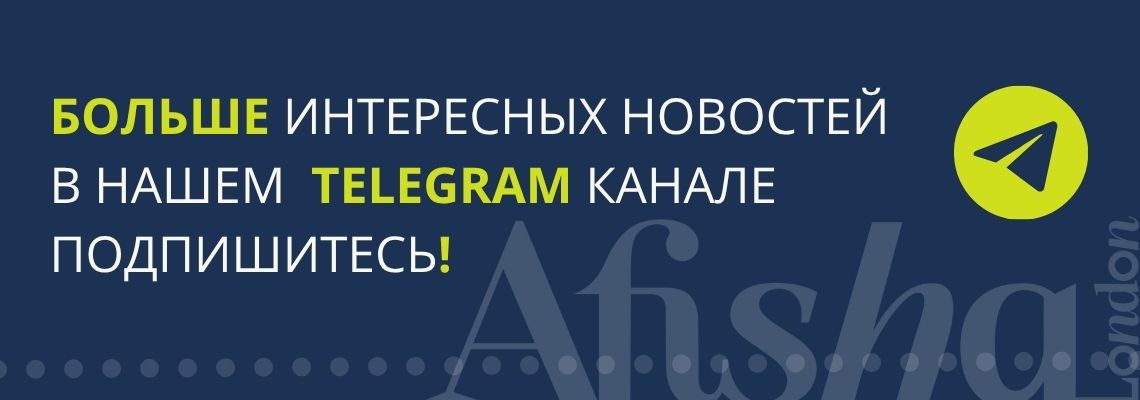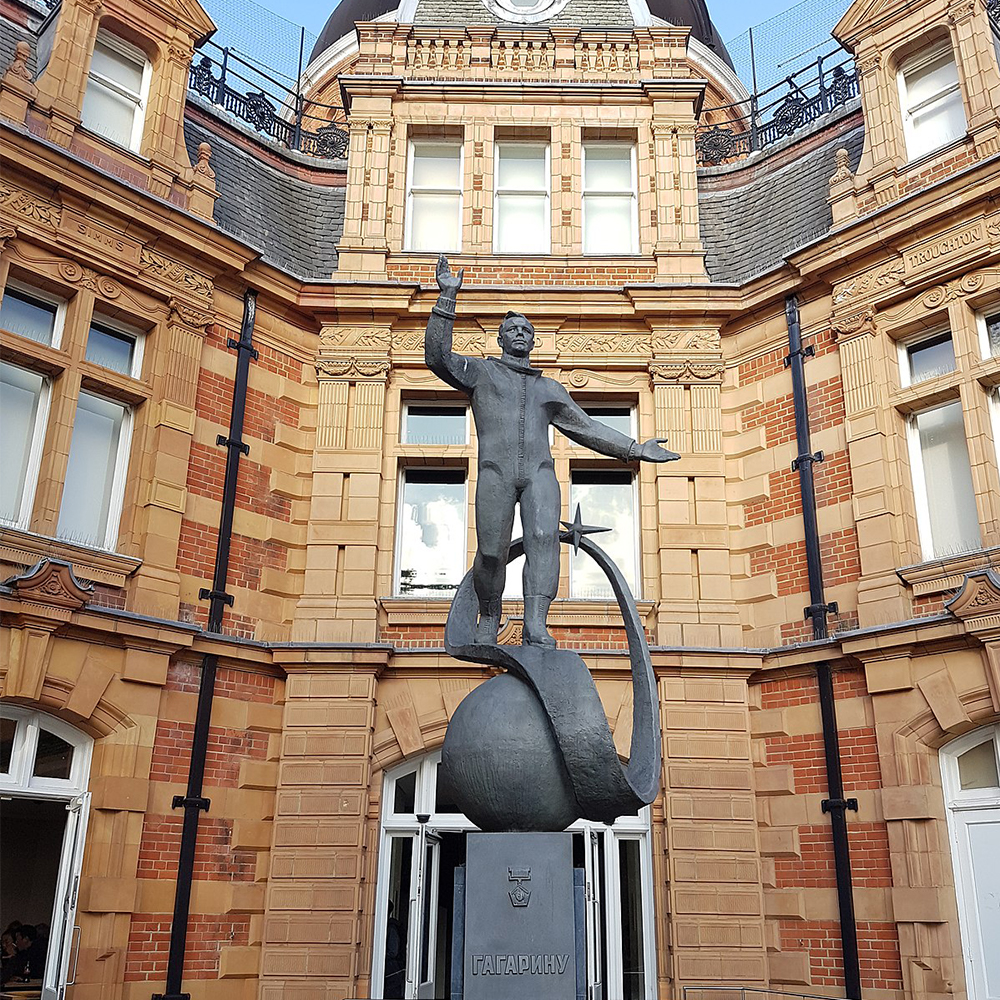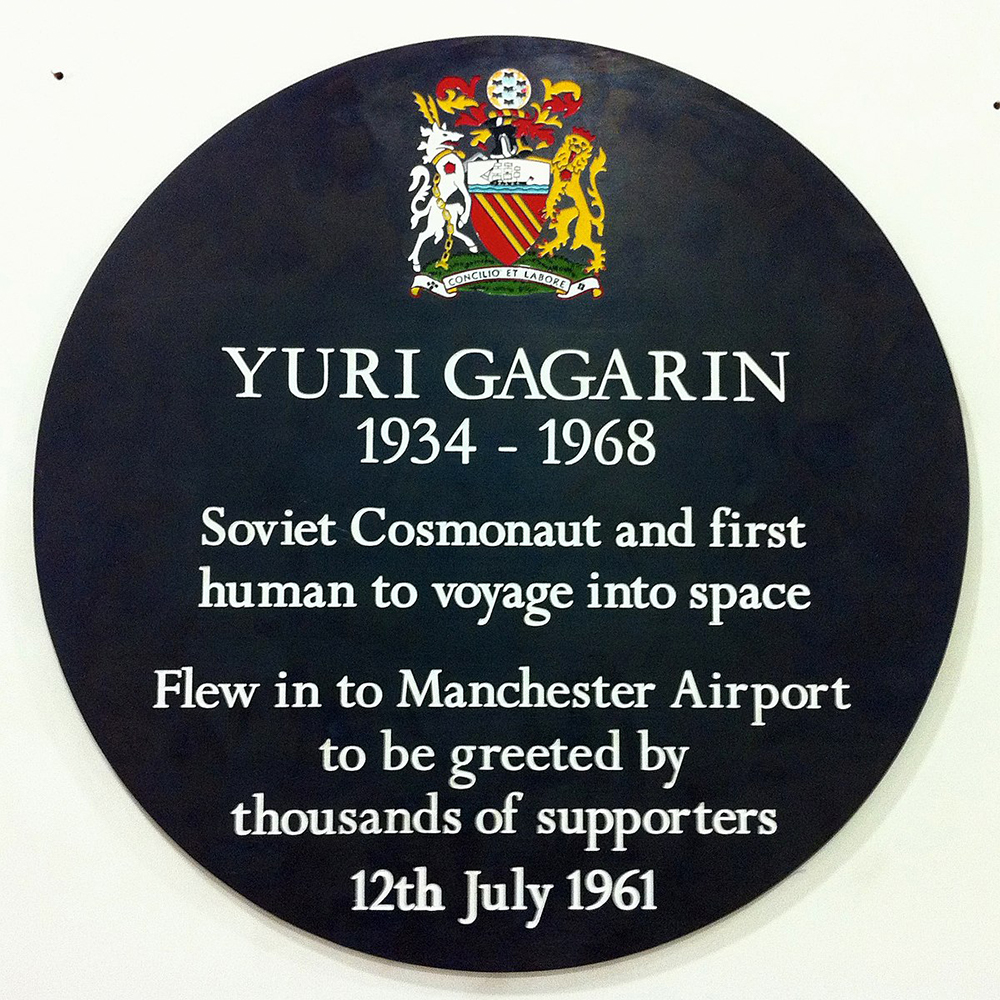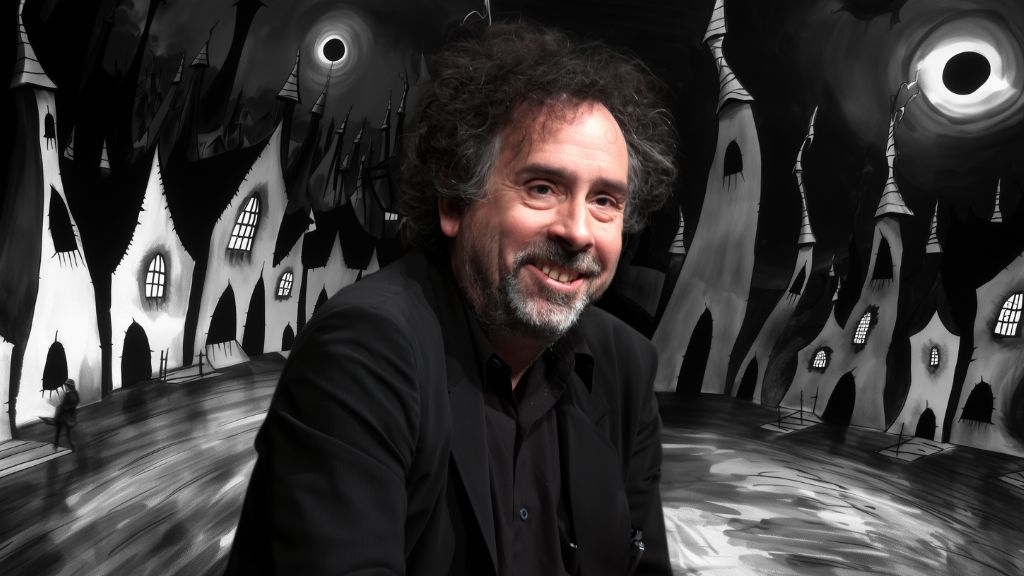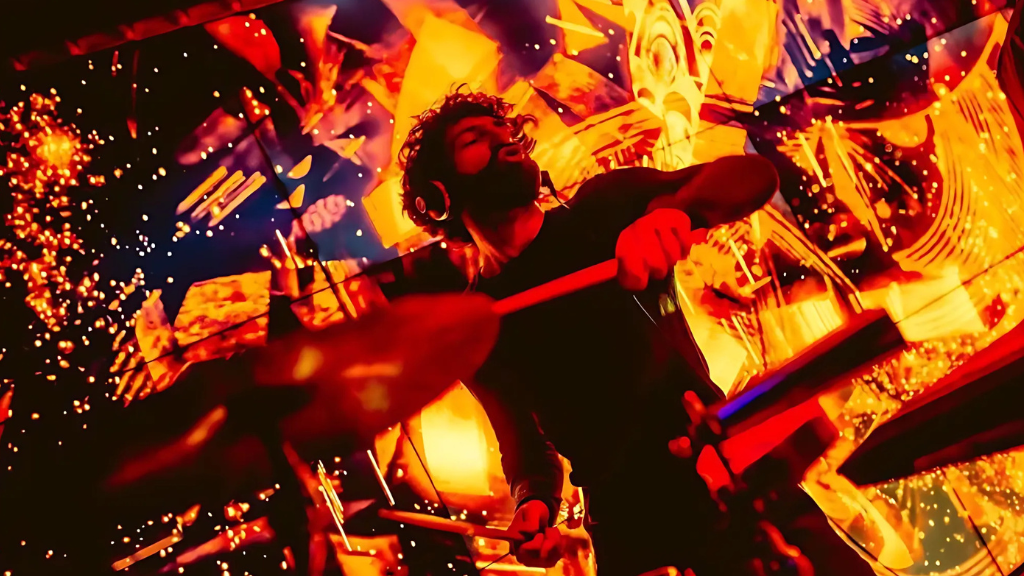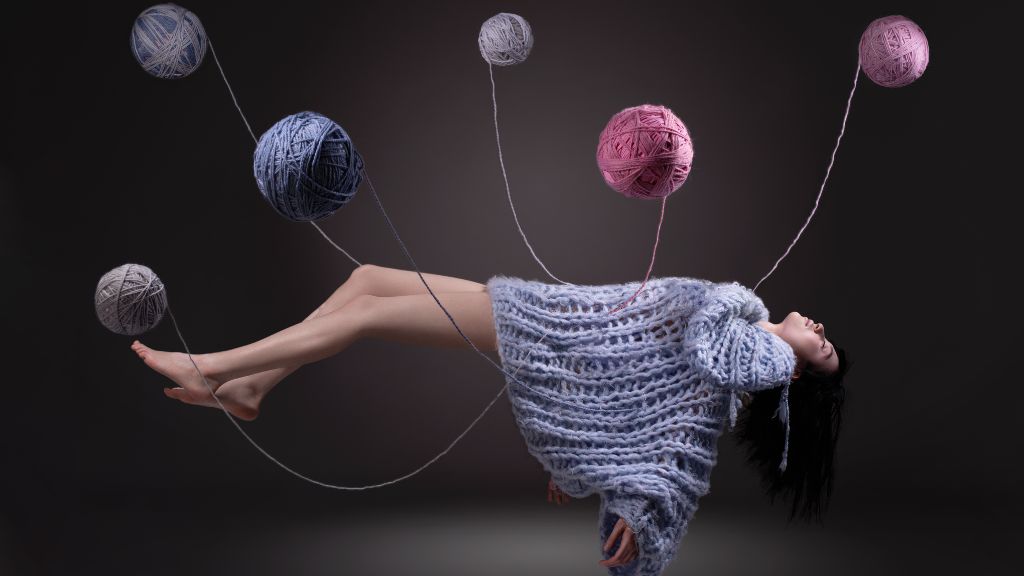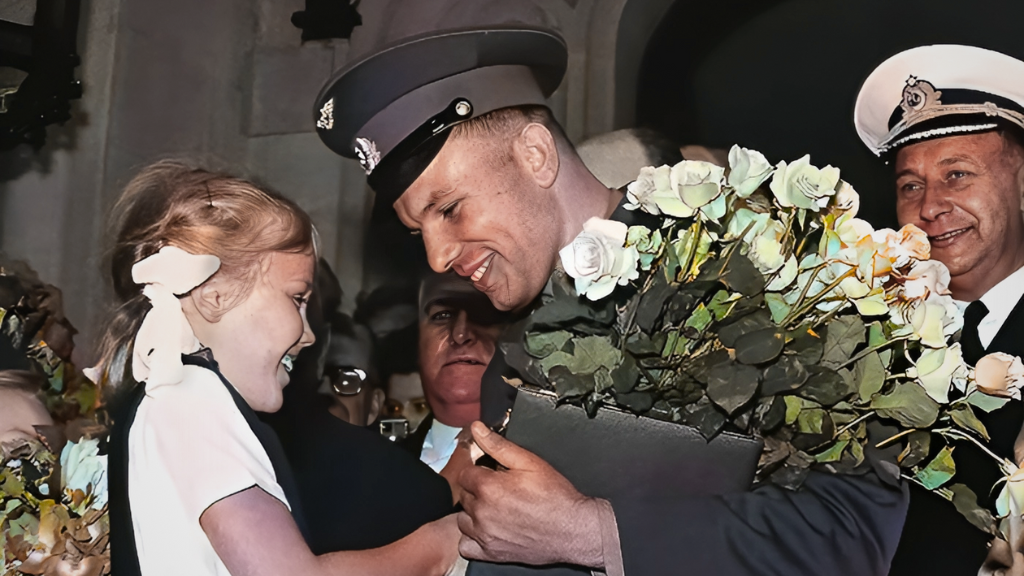
Yuri Gagarin in London: how to impress the Queen and become a British hero
Yuri Gagarin, who had the honour to represent humanity on Earth’s orbit, in the 1960s became a national hero and a shining beacon of socialism. He visited many countries, including Great Britain, attended a lunch with Elizabeth II and eased international tensions during the Cold War with his charming smile. Afisha.London magazine turned to archival documents, the works of historians and contemporaries of the cosmonaut in order to recall significant events associated with the first time a human ventured into outer space and the unforgettable visit of Gagarin to London.
Path to the stars
The choice of Yuri Gagarin as the captain of the first crewed spacecraft was determined by several factors. It seemed that fate itself rewarded him with all the necessary qualities for defying the Earth’s gravity: he was purposeful, physically prepared and hardworking, readily obeyed orders and dreamed of the sky.
In 1951, Yuri entered the Industrial Technical School in Saratov (now the Yuri Gagarin State Technical University of Saratov) to become a foundry worker, but he found his real calling in 1954 at the Saratov flying club and in the lectures of the scientist Konstantin Tsiolkovsky. Later Yuri would write: “Tsiolkovsky turned my whole soul upside down. I have a new disease — a thirst for the sky, a thirst for space”. By 1959, when a special commission began selecting the first twenty candidates in cosmonauts, Gagarin already was a senior lieutenant and an experienced military pilot.

16 pilots from the first Soviet cosmonaut squad, including Yuri Gagarin, with Sergei Korolev, his wife and daughter, and three trainers. Photo: Sputnik
While scientists and doctors were researching Gagarin’s physical and mental qualities, the government examined his personal relationships and even how he looks in photographs. The head of the USSR Nikita Khrushchev especially liked Gagarin’s portrait: the country needed an impeccable hero and a living symbol of socialism. The Soviet Union was in a state of protracted ideological struggle with the United States, and the space race was one of the ways to win this war. The USSR sought to become the first country to send a man into space: over the course of several years, seven unmanned vehicles flew into orbit, including the famous flight with the dogs Belka and Strelka on board.

Soviet cosmonauts (front row, from left): Vladimir Komarov, Yuri Gagarin, Valentina Tereshkova, Andriyan Nikolayev, Konstantin Feoktistov, Pavel Belyayev, second row: Alexey Leonov, Gherman Titov, Valery Bykovsky, Boris Yegorov, and Pavel Popovich. 1965. Photo: RIA Novosti archive, image #888102 / Alexander Mokletsov / CC-BY-SA 3.0, CC BY-SA 3.0, via Wikimedia Commons
The preparations for the flight under the leadership of Sergei Korolev and Nikolai Kamanin went on in complete secrecy. From the twenty candidates only six were selected, with Gagarin becoming an unofficial and then a recognised leader of the team, while German Titov was appointed his backup. Historian Vladimir Rossoshansky writes in his book The Gagarin Phenomenon that the team was trained in conditions of unthinkable nervous tension.
The famous text by the Telegraph Agency of the Soviet Union (TASS) was prepared in advance, and on April 12, 1961, it could be heard from all radio receivers in the USSR, when the pilot was already in orbit. The cosmonaut’s wife, Valentina, also learned about her husband’s flight from the radio broadcast: while Gagarin bravely conquered space for 108 minutes, his parents and loving family worried about him back on Earth — the pilot had two little daughters. The public’s reaction to the announcement was wild: in Moscow, cameramen from film studios took to the streets and filmed excited passers-by, while in the West, including the UK, the headlines were full of the incredible news.

Photo: Sputnik
Gagarin’s visit to Britain
After the spaceflight, Gagarin became a major, the Hero of the Soviet Union, the new face of the country and the envoy of peace. The first cosmonaut made official visits to many countries, and each of his trips and interviews was coordinated with the Central Committee of the Communist Party of the Soviet Union. Yuri’s “second orbit” — this is how journalists referred to his world tour — began on April 14, 1961 in Red Square and became the most successful diplomatic mission in history.
Read also: Yehudi Menuhin in London: prodigy, violinist and goodwill ambassador
In the summer, Gagarin reached the UK: his arrival was planned from 11 to 15 July as a private visit at the invitation of the National Union of Foundry Workers, who recognised him as one of their own. Great Britain supported the ideas of capitalism and in the Cold War was on the side of the United States, so the government was negatively predisposed towards the unexpected hero from the USSR. Prime Minister Harold Macmillan personally signed a decree advising not to hold receptions in honour of the cosmonaut, so only the Deputy Minister of Aviation was sent to the airport to officially greet the guest. The journalists were tasked with finding and highlighting Gagarin’s shortcomings, but when the Soviet pilot emerged from the plane with a smile everything went sideways.
This is what Kamanin, who accompanied Gagarin on that tour, later wrote: “The English people took the initiative into their own hands. The streets, which Gagarin passed, were covered in a dense carpet of umbrellas: under the drizzling rain, people waited for hours for the appearance of the Soviet cosmonaut. Londoners greeted Yuri Gagarin with such warmth and cordiality, with such a temperament that they refuted all our habitual notions of English restraint and calmness”. Daily Mail, the first British newspaper to greet the Soviet cosmonaut in a friendly manner, was then followed by The Guardian, The Times and The Daily Telegraph, which also renounced the official protocol and openly praised Gagarin.
Read also: Exploring Malevich: Locations and Insights into His Revolutionary Art
To drive around Gagarin was allocated with a silver Rolls-Royce bearing the license plate “YG 1”. First, the pilot went to Manchester, where the headquarters of the National Union of Foundry Workers was located and where he received a gold medal and a diploma of the honorary member of the united trade union of steel founders of England. In front of a crowd of thousands of workers at the Metropolitan-Vickers Electrical Co.
Yuri made a fiery speech about the solidarity of people of all countries in space exploration, which was followed by a red flag being erected on the Manchester Town Hall in honour of the cosmonaut and the local military band performing the Soviet anthem. In the British capital, the pilot inspected the Tower of London and received a book about the sights of the city signed with “In admiration — from the citizens of London” from the capital’s bankers, while at the Soviet trade fair in Earls Court all the coloured postcards with the face of Gagarin were sold out.

Yuri Gagarin visiting the Amalgamated Union of Foundry Workers in Manchester. Photo: ITAR-TASS/Alexei Struzhin
The reaction of the British public was so enthusiastic that the government had to literally change all plans on the go. On July 13, Macmillan invited Yuri to his temporary residence at the Admiralty: at the meeting, the cosmonaut handed Macmillan his book Road to the Stars, and the Prime Minister presented Yuri with a silver tray and admitted to reporters that Gagarin was a delightful and wonderful person. Afterwards, other British government officials did not hesitate to openly admire Gagarin and to ask him for autographs, but the main honour was still ahead — on July 14, Elizabeth II herself invited the cosmonaut to Buckingham Palace for lunch.
The Queen and the intricacies of royal protocol
The nuances of the British royal protocol did not allow arranging an official banquet in honour of Gagarin in the palace: five years earlier, even Khrushchev was greeted at the royal residence with only a tea party. Therefore, in order to comply with all the formalities, the cosmonaut was invited to lunch. Together with Gagarin, his biographer Nikolai Denisov, pilot Nikolai Kamanin, Soviet ambassador to Great Britain Aleksandr Soldatov and an interpreter were invited to Buckingham Palace. The delegation was led into a small living room, where they were introduced to Elizabeth II.
Read also: Bakst, Benois and Dobuzhinsky: How an Extensive Collection of Russian Art Ended Up in Oxford
Later, Kamanin would describe the memorable meeting this way: “A pleasant middle-aged woman entered the living room, very simply dressed, without jewellery and any traces of makeup — it was the Queen of England”. At lunch, served in the White Drawing Room, Gagarin was invited to sit next to the Queen, who listened with interest to his stories about space travel, while Prince Philip discussed with him the technical details of the flight.
This reception is now associated with numerous myths and legends: for example, there are rumours that after the visit of the cosmonaut, it became customary in the palace to drink tea in a “Russian way”, which meant eating a slice of lemon from the cup — such behaviour was previously considered to be the height of indecency by the English aristocrats. The reason for this was Gagarin’s directness, as he, while drinking tea with the Queen, followed the Russian habit and ate this ill-fated slice, to which the whole world would later devote so much attention. For Yuri, the sophistication of table etiquette was a novelty: he was trained to become an astronaut, not an aristocrat. Rossoshansky, a historian, in his biography of Gagarin describes another awkward situation that occured at the table: in the beginning of the lunch, Yuri, seeing a variety of cutlery and realising that exquisite manners were expected of him, announced: “Let’s eat like Russians”, took the largest spoon and served himself salad. The Queen supported him with the words “Gentlemen, let’s eat like Gagarin” and followed his example.
- Coins with Gagarin at the Science Museum. Photo: Afisha.London
- Photo: Afisha.London
The cosmonaut’s resourcefulness and charm impressed Elizabeth II so much that for the first time she violated royal etiquette and asked Gagarin to take a picture with her. Those present remember her explaining it with something along the lines of “I was photographed with a celestial, unearthly person and, therefore, did not violate anything”. The next day, English newspapers described in detail how the Queen received the guest with all the honours — the subtleties of protocol were forgotten, the country was jubilant. Christopher Riley, a British scholar specialising in the history of science, in his article For All Mankind would later point out that London fell victim to condemnation from its Western allies for showing such hospitality and breaking “solidarity”. However, according to Riley, the message of peace that Gagarin conveyed with his flight around the Earth may have helped prevent World War III.
Commemorating the first human spaceflight
Sixty years after Gagarin’s flight, the world still cherishes the memory of the first cosmonaut and his contribution to the history of science. In 1965 a monument with a sculpture of a rocket was erected at the place of his landing in the Saratov region, where now there also are an architectural complex Gagarinskoe Pole and a cedar alley (Kedr, Russian for cedar, was Gagarin’s call sign), which on April 12 will be joined by a new park — its opening will coincide with the 60th anniversary of the flight.
Read also: Boris Anrep in London: A Don Juan and the Love of Anna Akhmatova
In Saratov itself there is a large statue of the pilot located on the Cosmonauts Embankment. London also immortalised the memory of Gagarin with a sculpture in 2011, which is a copy of the famous monument to the first cosmonaut in Lyubertsy near Moscow. The London monument was opened by Gagarin’s daughter, Elena Yurievna, and Prince Michael of Kent — for several months the sculpture was exhibited in front of the British Council building, but is now located on the territory of the Royal Observatory in Greenwich.
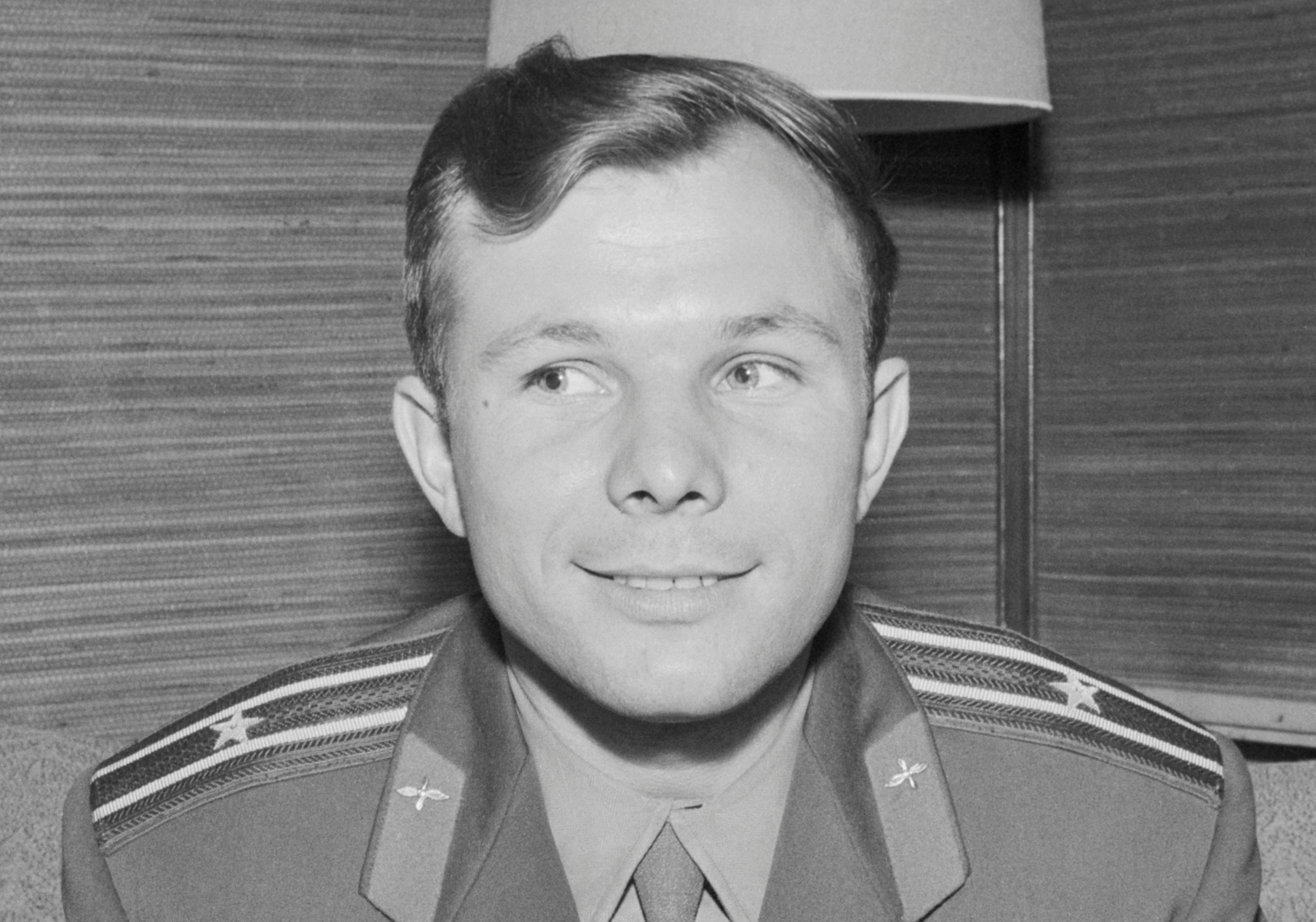
Yuri Gagarin at a press-conference in Finland. Photo: Adam Cuerden/Finnish Museum of Photography
The second monument to the cosmonaut in London, a bronze bust, was donated by the “Dialogue of Cultures — United World” foundation to the Science Museum in 2017 as part of the UK-Russia Year of Science and Education and is now on display at the museum’s permanent exhibition Exploring Space. According to Ian Blatchford, the director of the Science Museum, the bust of the first cosmonaut together with regular lectures on the Soviet spaceflight technologies reveal the history of the space program in full. The Science Museum also hosted the premiere of a Russian film Gagarin: First in Space by Pavel Parkhomenko, and is now successfully cooperating with the Tsiolkovsky State Museum of the History of Cosmonautics in Kaluga.
- Monument to Yuri Gagarin in Greenwich, London. Photo: Incabell, CC BY-SA 4.0, via Wikimedia Commons
- Memorial plaque in Manchester Airport. Photo: Photograph by Mike Peel (www.mikepeel.net)., CC BY-SA 4.0, via Wikimedia Commons
Manchester, where Gagarin inspired about 25,000 workers with his speech in 1961, honours the memory of the cosmonaut’s arrival with his portrait, which is installed in the Town Hall, while in Terminal 3 of the Manchester Airport one can see a commemorative plaque in honour of Gagarin. Every year, the UK continues to celebrate the International Day of Human Spaceflight with festive events, keeping adults and children alike interested in the history of science, new discoveries and future possibilities.
Irina Lazio/Liya Shapiro
Cover photo: Visit to London in July 1961, Hulton-Deutsch Collection/Corbis (color correction Afisha.London)
Invalid slider ID or alias.
Read more:
How Britain discovered Gorbachev, and Gorbachev discovered Britain
Rudolf Nureyev: an emigrant, who became a ballet legend
Felix Yusupov and Princess Irina of Russia: love, riches and emigration
SUBSCRIBE
Receive our digest once a week with quality Russian events and articles
